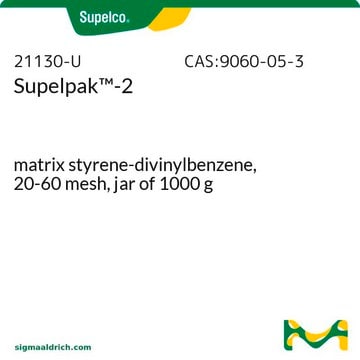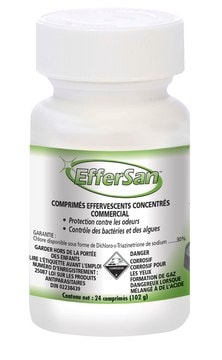The SLB-5ms excels in several performance criteria.· Low Bleed. The highly crosslinked silphenylene polymer chemistry reduces column bleed to a very low level, resulting in greater signal-to-noise level, allowing lower detection levels.· Inertness. The proprietary surface deactivation reduces interactions between analytes and the column surface, resulting in sharper peak shapes, allowing lower detection levels.· Durability. With the highest published maximum allowable operating temperature (MAOT) of any -5ms column, SLB-5ms columns are designed for long life.· Consistency. Innovative manufacturing processes result in decreased column variability, ensuring that the next column is as good as the last.
28465-U
SLB®-5ms
L × I.D. 10 m × 0.10 mm, df 0.10 μm
Sélectionner une taille de conditionnement
458,00 €
Sélectionner une taille de conditionnement
About This Item
458,00 €
Produits recommandés
Matériaux
fused silica
Niveau de qualité
Agence
Standard Method 6040D
EN 2005/108/EC
EPA 610,625,8015,8082,8100,8141,8270,OLM04.2 SVOA
EPA TO-13,IP-8,8270,525.2,608.1/608.2,608/8081/OLM04.2 PEST
JMHLW
NIOSH 2530,5503
OSHA 62
meets requirements for USP G27 and G36
suitable for EPA 1613
Conformité réglementaire
FDA LIB 4423
Paramètres
-60-340 °C temperature (isothermal)
-60-360 °C temperature (programmed)
Valeur bêta
250
df
0.10 μm
Technique(s)
GC/MS: suitable
gas chromatography (GC): suitable (fast GC)
L × D.I.
10 m × 0.10 mm
Groupe de la matrice active
Bonded and highly crosslinked; silphenylene polymer virtually equivalent in polarity to poly(5% diphenyl/95% dimethyl siloxane) phase
Application(s)
agriculture
chemicals and industrial polymers
cleaning products
clinical
cosmetics
environmental
flavors and fragrances
food and beverages
forensics and toxicology
industrial hygiene
life science and biopharma
personal care
petroleum
pharmaceutical (small molecule)
Type de colonne
capillary non-polar
Vous recherchez des produits similaires ? Visite Guide de comparaison des produits
Description générale
USP Code: This column meets USP G27 and G36 requirements.
Phase:
- Bonded and highly crosslinked
- Silphenylene polymer virtually equivalent in polarity to poly(5% diphenyl/95% dimethyl siloxane)
- ≤0.32 mm I.D.: -60 °C to 340 °C (isothermal) or 360 °C (programmed)
- ≥0.53 mm I.D.: -60 °C to 330 °C (isothermal) or 340 °C (programmed)
Autres remarques
Informations légales
Faites votre choix parmi les versions les plus récentes :
Déjà en possession de ce produit ?
Retrouvez la documentation relative aux produits que vous avez récemment achetés dans la Bibliothèque de documents.
Articles
The analysis of melamine and related compounds in dog food with the use of more economical gas chromatography-mass spectrometry (GC-MS) instrumentation.
Protocoles
Analysis of Adulterated Lemon Essential Oil on the SLB-5ms
GC Analysis of Sweet Orange Essential Oil on SLB®-5ms (10 m x 0.10 mm I.D., 0.10 μm), Fast GC Analysis
Contenu apparenté
This page is intended to make it easier to find the consumables you need based on the analytical method you’re using. Methods included on this page come from the EPA, Standard Methods and ASTM.
Chromatograms
suitable for GCsuitable for GCsuitable for GCsuitable for GCAfficher plus-
What are the benefits of the SLB™-5ms Capillary GC Column over other manufacturers’ -5ms columns?
1 answer-
Helpful?
-
-
Who uses SLB™-5ms Capillary GC Columns?
1 answer-
Any analyst with the need for a non-polar column. Some applications include boiling point separations, GC-MS analyses of semivolatiles, and GC-ECD analyses of pesticides/PCBs. It is estimated that non-polar columns account for 51% of the worldwide column market.
Helpful?
-
-
What if my method does not allow me to change to SLB™-5ms Capillary GC Columns?
1 answer-
These methods typically specify a 5-type column (DB-5 or equivalent). The SLB-5ms satisfies that requirement.
Helpful?
-
-
Would you recommend SLB™-5ms Capillary GC Columns for all applications instead of Equity-5, SPB-5, PTE-5, MDN-5, and MDN-5S?
1 answer-
Yes.
Helpful?
-
-
What is the Department of Transportation shipping information for this product?
1 answer-
Transportation information can be found in Section 14 of the product's (M)SDS.To access the shipping information for this material, use the link on the product detail page for the product.
Helpful?
-
-
How does the SLB™-5ms Capillary GC Column differ from our other 5-type columns?
1 answer-
Many of our other 5-type columns (Equity-5, SPB-5, PTE-5, MDN-5, and MDN-5S) incorporate a siloxane polymer (backbone comprised of Si and O atoms only, side groups are either methyl or phenyl). The SLB-5ms column incorporates a silphenylene polymer (backbone comprised of Si and O atoms plus some phenyl groups, side groups are either methyl or phenyl).
Helpful?
-
Active Filters
Notre équipe de scientifiques dispose d'une expérience dans tous les secteurs de la recherche, notamment en sciences de la vie, science des matériaux, synthèse chimique, chromatographie, analyse et dans de nombreux autres domaines..
Contacter notre Service technique




